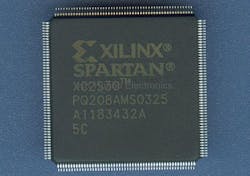Army opts for obsolete electronic technology to keep soldier and ground systems running
The Army Contracting Command in Warren, Mich., announced plans last week to buy 1,560 Xilinx Spartan IIE FPGAs from electronics distributor Avnet Corp. in Phoenix. Xilinx introduced the Spartan II FPGA family in early 2000, and the technology is nearly 14 years old.
Furthermore, the Xilinx Spartan IIE data sheet, which is dated 9 Aug. 2013, is stamped OBSOLETE four times at the top of each page in large red block capital letters. The value of the Army's upcoming contract to Avnet has yet to be negotiated.
Legacy military electronics often are designed with specific components in mind, and upgrading parts like FPGAs can involve costly system redesigns of the kind that Army commands often cannot afford today. Sometimes the only way to replace worn-out parts is to use parts for which the system was designed originally. Unfortunately this can mean using obsolete parts.
The Army's need to procure obsolete electronic parts, which not only offer only limited capability but also are difficult to find, underscores the dangers of compromised military capability as a result of sequestration and other continued downward pressure on the U.S. Department of Defense budget.
The TACOM LCMC consists of the Army Contracting Command-Warren; Integrated Logistics Support Center; Program Executive Office Combat Support & Combat Service Support; Program Executive Office Ground Combat Systems; Program Executive Office Soldier; Joint Program Executive Office for Chemical and Biological Defense; System of Systems Engineering & Integration Directorate, U.S. Army Tank Automotive Research, Development and Engineering Center; U.S. Army Armaments Research, Development & Engineering Center; Natick Soldier Research, Development & Engineering Center; and the Edgewood Chemical Biological Center.
The seven-member Xilinx Spartan II FPGA family offers densities ranging from 50,000 to 600,000 system gates. System performance is supported beyond 200 MHz. Features include block RAM (to 288K bits), distributed RAM (to 221,184 bits), 19 selectable I/O standards, and four delay-locked loops (DLLs).
Xilinx introduced the Spartan-IIE family originally as an alternative to mask-programmed application-specific integrated circuits (ASICs), and as programmable hardware that enables design upgrades in the field with no hardware replacement, Xilinx officials say.
FPGAs have programmable gates that enable users to change their functionality without removing them from their systems. Xilinx today is many generations ahead of the Spartan II in its FPGA technology.
Army officials say they plan to award a contract to Avnet late this month. More information is online at https://www.fbo.gov/notices/c53e52d3eb7ebfdb274a5c155a2979f9.

